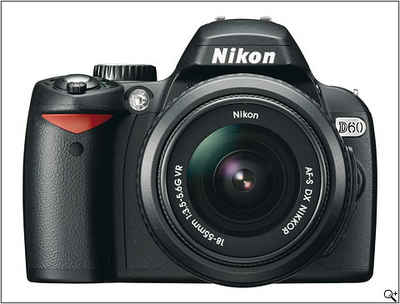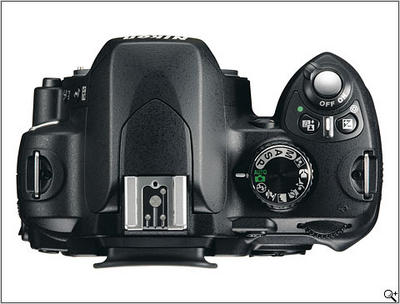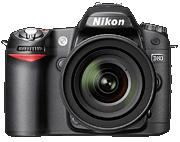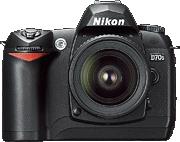a quick googling
d60:
http://www.dpreview.com/news/0801/08012910nikond60.asp
d80:http://www.dpreview.com/reviews/nikond80/
D60
Nikon Europe Debuts D60 Digital Single Lens Reflex Camera

User-friendly Nikon D60 offers 10-megapixel resolution, in-camera editing
Amsterdam, the Netherlands, 29 January 2008
- Nikon Europe today announced the debut of the Nikon D60, a digital
SLR designed for the consumer who wants to combine top technology with
user-friendliness and creative features. The D60 provides a resolution
of 10.2 effective megapixels, Nikon’s exclusive EXPEED image-processing
concept, in-camera editing functions and a 3-area auto focus system.
The camera offers continuous shooting at 3.0 fps, near instant power-up
in just 0.19 seconds and high ISO sensitivity, all in a compact,
lightweight body with a user-friendly ergonomic design.
The
Nikon D60 is designed to simplify camera operation and allow the
photographer to concentrate on taking pictures. The camera’s simple,
user-friendly design includes a reduced number of buttons and a
combined monitor and information display. A 2.5-inch LCD screen
presents information using an easy to understand graphic user
interface, with three types of presentation style to suit all users.
The symbols and numbers in the display rotate through 90 degrees,
presenting information in the correct orientation according to how the
camera is being held. The D60 also includes a new feature that turns
off the LCD monitor screen automatically when the viewfinder is in use.
The D60 utilizes Nikon’s exclusive EXPEED technology to maximize image
quality and processing speed. The camera also offers creative features
that are designed to allow the optimisation and adjustment of images
without the need for a computer. Image optimisation is achieved through
functions like Active D-Lighting (which compensates for strong
shadows), and the automatic correction of false eye colour when using
the built-in flash. Creative features include the automated creation of
stop-motion animation files from a sequence of images, and effects that
simulate the use of optical filters to produce colour shading and
sparkling highlights.
To
combat the dust that can be introduced into the camera body when
changing lenses, , the D60 includes an integrated dust reduction
system. Nikon’s exclusive Airflow Control System channels dust out of
the image path and a vibrating, self-cleaning sensor unit shakes off
any remaining dust from the camera’s optics.
The
Nikon D60 standard kit comes with a high-performance VR-NIKKOR lens,
the AF-S DX NIKKOR 18-55mm f/3.5-5.6G VR. Compact and lightweight, the
lens offers 3x zoom with a versatile focal length range of 27mm to
82.5mm (35mm-format equivalent). Nikon’s advanced Vibration Reduction
technology combats the effect of camera shake, allowing the use of
shutter speeds that are up to three times slower than is practical with
non-VR lenses. And with its sophisticated, leather-toned design, the
lens looks as good as the pictures it takes. “The D60 is intended to
put high quality photography within the reach of ordinary consumers.”
said Toru Uematsu, Manager Prosumer Products at Nikon Europe B.V “The
combination of precision technology and carefree convenience places the
D60 in a unique position of offering compact camera users the chance to
move up to digital SLR with ease and security.”

The
D60 is capable of use in a range of lighting conditions due to a wide
sensitivity range of ISO 100 to ISO 1600 and offers vivid colour
reproduction with clear, sharp results.. For convenient use in places
where flash photography is not allowed, the camera will set the
sensitivity automatically for the best results . The camera’s built-in
Speedlight produces excellent balanced results thanks to Nikon’s
sophisticated i-TTL flash system, and also allows the use of additional
remote-controlled Speedlights.
Storing images
on highly-compact SD memory cards (compatible with SDHC), the D60 body
measures approximately 126 (W) x 94 (H) x 64 (D) mm and weighs 495
grams. Supplied accessories include a rechargeable Li-ion battery,
quick charger, USB cable, rubber eyecup, camera strap, body cap,
eyepiece cap and accessory shoe cap. The provided software includes the
Nikon Software Suite on CD-ROM. Software for photofinishing and camera
remote control may be purchased separately as an option. Suggested
retail pricing for the D60 Kit with AF-S DX Nikkor 18-55mm f/3.5-5.6G
VR is €699. Other kits are available.
Nikon D60 specifications

Body color
Black
Sensor
• 23.6 x 15.8 mm CCD sensor
• Nikon DX format (1.5x FOV crop)
• 10.2 million effective pixels
• 10.8 million total pixels
• RGB Color Filter Array
• 12-bit A/D converter
Anti-dust measures
• Image sensor cleaning system*
• Airflow control system*
• Image dust off from reference frame (using optional Capture NX software)
Image sizes
• 3872 x 2592 (Large, 10.0 MP)
• 2896 x 1944 (Medium, 5.6 MP)
• 1936 x 1296 (Small, 2.5 MP)
Image quality
• NEF (12-bit compressed RAW)
• JPEG fine (1:4)
• JPEG normal (1:8)
• JPEG basic (1:16)
• NEF (RAW) + JPEG basic
Color space
• IIIa (sRGB - more green for colourful landscapes) default
• Ia (sRGB)
• II (Adobe RGB)
Lens mount
Nikon F mount (with AF contacts)
Lens compatibility
• AF-S, AF-I
• Other Type G or D AF Nikkor
• Other AF Nikkor/AI-P Nikkor
• Type D PC Nikkor
• Non-CPU
• IX Nikkor/AF Nikkor for F3AF
-All functions supported
- All functions supported except autofocus
- All functions supported except autofocus and 3D Color Matrix Metering II
- All functions supported except some shooting modes
- Can be used in mode M, but exposure meter does not function;
electronic range finder can be used if maximum aperture is f/5.6 or
faster
- Can not be used
Autofocus
• Three area TTL phase detection
• Nikon Multi-CAM530 autofocus module
• Only with AF-S or AF-I lenses
• Detection range: EV -1 to +19 (ISO 100 equivalent, at normal
temperature)
Lens servo
• Single-servo AF (AF-S)
• Continuous-servo AF (AF-C)
• Automatic AF-S/AF-C (AF-A)
• Manual focus (M)
AF Area mode
• Single Area AF
• Dynamic Area AF
• Closest Subject Priority Dynamic Area AF
Focus tracking
Predictive focus tracking automatically activated according to subject status in continuous-servo AF
Focus area
One of three areas can be selected
Focus lock
Focus can be locked by pressing
shutter-release button halfway (single-servo AF) or by pressing AE-L/AF-L
button
AF Assist
White light lamp
Exposure mode
• Digital Vari-program
- Auto
- Flash off
- Portrait
- Landscape
- Child
- Sports
- Close up
- Night portrait
• Programmed auto (P) with flexible program
• Shutter-priority auto (S)
• Aperture priority auto (A)
• Manual (M)
Metering
TTL full-aperture exposure metering
system
• 3D color matrix metering II
• 420 segment RGB sensor
• Center-weighted: Weight of 75% given to a 8mm circle in center of frame
• Spot: Meters 3.5 mm circle (about 2.5% of frame) centered on active
focus area
Metering range
• EV 0 to 20 (3D color matrix
or center-weighted metering)
• EV 2 to 20 (spot metering) (ISO 100 equivalent, f/1.4 lens,
20 °C)
Meter coupling
CPU coupling
Exposure compen.
• +/- 5.0 EV
• 1/3 EV steps
AE Lock
Exposure locked at detected value with AE-L/AF-L button
AE Bracketing
None
Sensitivity
• Auto
• ISO 100
• ISO 200
• ISO 400
• ISO 800
• ISO 1600
• ISO 3200 equiv. (HI 1)
Auto ISO options
• On/Off
• Maximum ISO (200, 400, 800 or 1600)
• Minimum shutter speed (1 to 1/125 sec)
Shutter
• Combined mechanical and CCD
electronic shutter
• 30 to 1/4000 sec (1/3 EV steps)
• Flash X-Sync: up to 1/200 sec
• Bulb
White balance
• Auto (TTL white-balance with 420 pixels RGB sensor)
• Six manual modes with fine-tuning
o Incandescent
o Fluorescent
o Direct sunlight
o Flash
o Cloudy
o Shade
• Preset white balance (immediate or from photo)
WB fine tuning
Yes
Image parameters
• Preset modes: Normal, Softer, Vivid, More Vivid, Portrait, B&W
• Sharpening: Auto, 6 levels
• Tone: Auto, 5 levels, Custom curve
• Color mode: Ia (sRGB), II (Adobe RGB), IIIa (sRGB)
• Saturation: Auto, 3 levels
• Hue: -9° to +9°
Viewfinder
• Optical fixed eye-level
• Penta-mirror type
• Built-in diopter adjustment (-1.7 to +0.5 m-1)
• Eyepoint: 18 mm (at -1.0 m-1)
• Frame coverage 95% (approx.)
• Viewfinder magnification approx. 0.8x with 50mm lens at infinity;
-1.0 m-1
• Focusing screen: Type B BriteView clear matte screen Mark V with superimposed focus brackets
Viewfinder information
Focus
indications, AE/FV lock indicator, Shutter speed, Aperture value,
Exposure/Exposure compensation indicator, Exposure mode, Flash output
level compensation, Exposure compensation, Number of remaining
exposures, Flash-ready indicator
LCD monitor
• 2.5" TFT LCD
• 230,000 pixel
• Features automatic defeat via Eye Sensor*
Built-in flash
• Auto pop-up in Auto, Vari-program modes
• Manual pop-up in P, S, A or M modes
• Guide number approx. 12 at ISO 100
Sync contact
X-contact only; flash synchronization at shutter speeds of up to 1/200 sec
Flash control
• TTL flash control by 420-segment RGB sensor. i-TTL balanced fill-flash for digital SLR
and standard i-TTL fill-flash for digital SLR available when CPU lens is used with built-in
flash, SB-400, SB-800, and SB-600
• Auto aperture with SB-800 and CPU lenses
• Non-TTL auto with SB-800, 80DX, 28DX, 28, 27 and 22s
• Range-priority manual with SB-800
Flash mode
• Auto, Portrait, Child, Close-up: Auto, auto with red-eye reduction; fill-flash and red-eye reduction
available with optional Speedlight
• Night portrait: Auto, auto slow sync, auto slow sync with red-eye reduction; slow sync and slow
sync with red-eye reduction available with optional Speedlight
• Landscape, Sports: Fill-flash and red-eye reduction available with optional Speedlight
• P, A modes: Fill flash, rear-curtain with slow sync, slow sync, slow sync with red-eye reduction,
red-eye reduction
• S, M modes: Fill flash, rear-curtain sync, red-eye reduction
Flash compensation
• -3 to +1 EV
• 1/3 steps
Nikon Creative Lighting system
Supported with built-in flash, SB-400, SB-800, and SB-600; Advanced Wireless Lighting
supported with SB-800 or SU-800 as Commander.
Shooting modes
• Single frame shooting (S)
mode
• Continuous shooting (C) mode: approx. 3.0 frames per second (slower with NR)
• Self-timer/remote control mode.
Continuous buffer
• JPEG: Limited only by storage
• RAW: Approx. 9 frames (shooting continues at a slower rate)
Self-timer
• 2, 5, 10 or 20 sec
Remote control
• Remote Control ML-L3 (optional, Infrared)
• Camera Control Pro software (optional)
Text input
Up to 36 characters of alphanumeric
text input is available with LCD monitor and multi-selector; stored
in EXIF header
Playback functions
• Full frame
• Thumbnail (4 or 9 segments)
• Zoom (magnified)
• Slideshow
• Histogram indication
• Shooting data
• Highlight point display
• Auto image rotation
• Stop-motion movies created with D60*
Orientation sensor
Yes (Rotates user interface when using camera in portrait orientation)*
Storage
• Secure Digital / Secure Digital HC
• FAT / FAT32
• Supports firmware update via SD card
Video output
NTSC or PAL selectable
Connectivity
• USB 2.0 (Hi-Speed)
• Mass storage / PTP selectable
• Video out
• DC-IN (optional AC adapter and adapter connector)
Languages
Chinese (Simplified and Traditional), Dutch, English, Finnish, French, German, Italian,
Japanese, Korean, Polish, Portuguese, Russian, Spanish, Swedish
Power
Lithium-Ion battery pack
EN-EL9 (7.4 V, 1000 mAh)
Working environment
• 0 to 40°C (32 to 104°F)
• Less than 85% humidity
Dimensions
126 x 94 x 64 mm (5.0 x 3.7 x 2.5 in)
Weight (no batt)
471 g (1.0 lb)
Weight (inc. batt)
522 g (1.2 lb)
Supplied accessories
Rechargeable
Li-ion Battery EN-EL9, Quick Charger MH-23, USB Cable UC-E4,
PictureProject, Rubber Eyecup DK-16, Camera Strap, Body Cap BF-1A,
Eyepiece Cap DK-5, Accessory Shoe Cap BS-1
Optional accessories
Wireless
Remote Control ML-L3, Capture NX, Camera Control Pro, AC Adapter
Connector EP-5, AC Adapter EH-5, Video Cable EG-D100, Semi Soft-Case
CF-DC1, Speedlight SB-800/600/T041/R1C1
D80
Two and a half years ago Nikon announced the six
megapixel D70, their first affordable enthusiasts digital SLR, it
proved to be a very popular camera and strong competitor to the Canon
EOS 300D (Digital Rebel). Just fifteen months later Nikon revealed the
D70s which was essentially the same camera with a some subtle tweaks
(improved AF, wider flash coverage, higher capacity battery, larger LCD
monitor). And so just over fifteen months on from the D70s Nikon
present the latest incarnation of their 'enthusiasts' digital SLR line,
the ten megapixel D80.
The D80 slots nicely
between the entry-level D50 and the semi-professional / professional
D200, clearly based on the D70 design but also different enough to be
seen as a completely new model. It features a ten megapixel DX format
CCD (the same we presume as used by Sony in the DSLR-A100), the
metering sensor from the D50 and numerous other items taken or modified
from the D200.
UPDATE 18/Dec/06:
In our original review a mistake was made in the measurement of the ISO
sensitivity of the Canon EOS 400D as used for comparison, this has now
been corrected and the releveant pages of this review updated.
Key features
- 10.2 megapixel DX format CCD (1.5x FOV crop)
- Image processing engine (similar to D200 / D2X)
- 3D Color Matrix Metering II, 420 pixel sensor (same as D50)
- 11-area AF system (new version of Multi-CAM 1000, similar to D200)
- Custom Auto ISO (selectable maximum ISO, minimum shutter speed)
- Configurable high ISO and long exposure noise reduction
- Mechanical only shutter (maximum 1/4000 sec, flash sync to 1/200 sec)
- Quoted 80 ms shutter lag (short viewfinder blackout; 160 ms)
- Larger, brighter pentaprism viewfinder (x0.94 magnification)
- Support for SD-HC (SD cards over 2 GB in capacity)
- In-camera retouching
- D-Lighting (shadow / highlight enhancement)
- Red-eye reduction
- Trimming
- Monochrome
- Filter effects
- Small picture
- Image overlay
- Multiple-exposures
- Compact body (smaller, lighter than D70/D70s)
- Improved menu user interface (same as D200)
- Higher capacity EN-EL3e battery (provides detailed information, same as D200)
- Wireless flash integration (same as D200)
Compared to the Nikon D70s, major feature and specification differences
As
you can see from the table below the D80 carries some quite significant
improvements compared to the D70s, the only slight negative point being
slightly slower maximum shutter speed and flash sync (this due to a
lack of an electronic shutter).

Nikon D80

Nikon D70s
Sensor
• 10.2 million effective pixels
• 23.6 x 15.8 mm CCD (DX format)
• 6.1 million effective pixel
• 23.7 x 15.6 mm CCD (DX format)
Image sizes
• 3872 x 2592 (10.0 MP)
• 2896 x 1944
• 1936 x 1296
• 3008 x 2000 (6.0 MP)
• 2240 x 1488
• 1504 x 1000
Autofocus
• 11 area TTL
• Nikon Multi-CAM1000
• 5 area TTL
• Nikon Multi-CAM900
Lens servo
• Single-servo AF (AF-S)
• Continuous-servo AF (AF-C)
• Automatic AF-S/AF-C (AF-A)
• Manual focus (M)
• Single-servo AF (AF-S)
• Continuous-servo AF (AF-C)
• Manual focus (M)
Metering
• 420 pixel RGB sensor
• 3D color matrix metering II
• 1005 pixel RGB sensor
• 3D color matrix metering
Metering range
• EV 0 to 20 (3D color matrix / CW)
• EV 2 to 20 (Spot)
• EV 0 to 20 (3D color matrix / CW)
• EV 3 to 20 (Spot)
Sensitivity
• ISO 100 - 1600
• Up to ISO 3200 with boost
ISO 200 - 1600
Auto ISO
• Selectable maximum ISO
• Selectable minimum shutter speed
On/Off
Shutter
Electronically controlled vertical-travel focal plane shutter
Combined mechanical and CCD electronic shutter
Shutter speed
• 30 to 1/4000 sec
• Bulb
• 30 to 1/8000 sec
• Bulb
Flash sync
1/200 sec
1/500 sec
Built-in flash
Guide number 13 (ISO 100)
Guide number 11 (ISO 100)
Continuous
• 3 fps
• 23 / 6 frames (JPEG / RAW)
• 3 fps
• 12 / 4 frames (JPEG / RAW)
White balance
• Auto
• 6 presets
• Kelvin color temperature
• Manual preset (immediate or from photo)
• Auto
• 6 presets
• Manual preset (immediate)
Image presets
Normal, Softer, Vivid, More Vivid, Portrait, B&W
Normal, Vivid, Sharper, Softer, Direct Print, Portrait, Landscape
High ISO NR
• Normal
• Low
• High
• Off
Fixed
Multiple exposures
Yes
No
Exposure delay
Yes, optional, 0.4 sec (mirror lock-up)
No
Viewfinder
• Eyepoint: 19.5 mm (at -1.0 m-1)
• Frame coverage 95% (approx.)
• Magnification approx. 0.94x
• B-type Bright View Clear Matte II
• Eyepoint: 18.0 mm (at -1.0 m-1)
• Frame coverage 95% (approx.)
• Magnification approx. 0.75x
• B-type Bright View Clear Matte II
LCD monitor
• 2.5" TFT LCD
• 230,000 pixel TFT
• 170 degree viewing angle
• Removable protective cover
• 2.0" TFT LCD
• 130,000 pixel TFT
Histogram
Luminance & RGB histogram
Luminance histogram
USB
USB 2.0 Hi-Speed (480 Mbps max.)
USB 2.0 Full-Speed (12 Mbps max.)
Storage
SD / SD-HC card
Compact Flash Type I or II
Battery
Lithium-Ion EN-EL3e (7.4 V, 1500 mAh)
Lithium-Ion EN-EL3a (7.4 V, 1400 mAh)
Battery status
• Remaining charge (%)
• No. of shots taken since last charge
• Battery life (5 stage)
3 level on LCD panel
Vertical grip
MB-D80 (optional)
None (third party only)
Dimensions
132 x 103 x 77 mm (5.2 x 4.1 x 3.0 in)
140 x 111 x 78 mm (5.5 x 4.4 x 3.1 in)
Weight
• No battery: 585 g (1.3 lb)
• With battery: 668 g (1.5 lb)
• No battery: 595 g (1.3 lb)
• With battery: 679 g (1.5 lb)
Image processing engine
• New for D80
• Based on D200 / D2X
• 12-bit algorithms, 2-channel
Unknown
Programmable FUNC button
Yes
No
In-camera retouching
• D-Lighting
• Red-eye reduction
• Trimming
• Overlay
• Monochrome and Filter
• Small picture
• Image overlay
No
Top panel controls
• Metering mode
• Exposure compensation
• Shooting mode
• AF mode
• Metering mode
• Exposure compensation
World time
Yes
No
